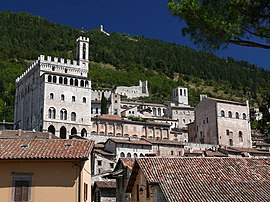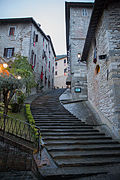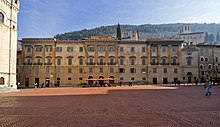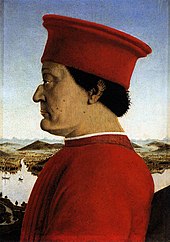Gubbio
| Gubbio | ||
|---|---|---|

|
|
|
| Country | Italy | |
| region | Umbria | |
| province | Perugia (PG) | |
| Coordinates | 43 ° 21 ' N , 12 ° 34' E | |
| height | 522 m slm | |
| surface | 525 km² | |
| Residents | 31,324 (Dec. 31, 2019) | |
| Population density | 60 inhabitants / km² | |
| Post Code | 06024, 06020 | |
| prefix | 075 | |
| ISTAT number | 054024 | |
| Popular name | Eugubini | |
| Patron saint | Sant'Ubaldo Baldassini (May 16) | |
| Website | Gubbio | |
 Panorama of Gubbio |
||
Gubbio is a town in the region of Umbria in Italy with 31,324 inhabitants (December 31, 2019), the Eugubini be called (the actual city area has 17,000 inhabitants). In ancient times the place was called Iguvium , since the Middle Ages it was called Agobbio , the inhabitants Agobbini .
Gubbio is the seat of the Gubbio diocese of the Roman Catholic Church .
geography
Gubbio is located at an altitude of 522 m on the slopes of Monte Ingino in the Apennines, about 35 kilometers northeast of the regional capital Perugia . The Chiascio river has its source in the southeastern municipality .
The districts include Belardello, Bellugello, Bellugello Biscina, Belvedere, Birello, Borgo Torre, Branca, Caibelli, Caicambiucci, Caimariotti, Camporeggiano, Canalecce, Carbonesca, Carestello, Carpiano, Casacce, Casamorcia, Casanova di Torre, Case Colle, Case Fontarcano, Case Mocaiana, Case Monteleto, Case Santa Maria Maddalena, Case Sant'Erasmo, Case Vignoli, Cima San Benedetto, Cipolleto, Colombara, Colonnata, Colpalombo, Corraduccio, Decima, Febino Casacce, Fontanelle, Fonte Cese, Fonte della Salsa, Ghigiano, Goregge , Intonacato Basso, Lastreto, Le Trosciacce, Loreto Basso, Madonna del Ponte, Mengara, Mocaiana, Molino di Camporeggiano, Montanaldo, Monteleto, Montelovesco, Monteluiano, Morena, Murcie, Nerbisci, Nogna, Padule, Padazzule-San Marco, Palazzaccio , Petroia, Pian Grande, Piccola Piaggiola, Pieve di Agnano, Pisciano, Raggioli, Ritirata, Salia, Salia Parrocchia, San Bartolomeo, San Bartolomeo di Burano, San Benedetto Vecchio, San Cristoforo Basso, San Marco, San Martino in Colle, Santa Cristina, Santa Margherita di Burano, Sant'Ubaldo, Scritto, Semonte, Semonte - Casamorcia, Semonte Castello, Serrabrunamonti, Sorbo, Spaccio Monteluiano, Spada, Stazione di Camporeggiano, Stazione di Padule, Torre Calzolari, Torre dell ' Olmo, Valdichiascio, Vallingegno, Venata, Vignoli, Villamagna and Zangolo.
The neighboring municipalities are Cagli ( PU ), Cantiano (PU), Costacciaro , Fossato di Vico , Gualdo Tadino , Perugia , Pietralunga , Scheggia e Pascelupo , Sigillo , Umbertide and Valfabbrica .
history
Iguvium was an important center of the Umbrians on an important road from the Tyrrhenian Sea to the Adriatic over the pass of Scheggia. Iguvium minted its own coins with the inscriptions IKVVINI and IKVVINS as early as pre-Roman times . Probably from the 3rd century BC. The oldest of the seven bronze tablets ( Iguvinian tablets ), whose religious rules are among the most important testimonies to the Umbrian language , date from the 4th century BC .
From 268 B.C. Iguvium belonged to the Roman sphere of influence as civitas foederata ("allied city") and served the Romans in 167 BC. As a place of exile for the Illyrian king Genthios . After the alliance war , the inhabitants became Roman citizens; henceforth the city belonged as a Municipium to the Tribus (voting district) Clustumina . Iguvium was founded at the beginning of the Civil War in 49 BC. Captured by the troops of Gaius Julius Caesar . At the time of Augustus, the city was moved from the top of Monte Ingino down to its slopes. During the Roman Empire, Iguvium lost its importance because the Via Flaminia only passed the city a few miles away. Archaeological remains include a theater from the 1st century AD, as well as remains of houses, kilns and graves. In today's district of Monteleto on the edge of the ancient territory of the city there was a large temple.
Iguvium was a base on the Byzantine Corridor that linked Rome and Ravenna. In the Middle Ages, Gubbio was independent from the beginning of the 12th to the middle of the 14th century. In 1384 the city submitted to the House of Montefeltro in a battle with its bishop . After its extinction in 1508, Gubbio fell to the della Rovere family , together with the Duchy of Urbino , and after their extinction in 1631 it became part of the Papal States .
Today's center is medieval and characterized by narrow streets and Gothic buildings. The outstanding building is the Palazzo dei Consoli , in which the Iguvinian tablets are kept.
During the Second World War, Gubbio was the scene of a massacre by the German Wehrmacht. Soldiers of the 114th Jägerdivision shot 40 inhabitants of the village in retaliation for a partisan attack on June 22, 1944.
The novel Journey in the Moonlight by Antal Szerb is partly about Gubbio.
Attractions
The cities of Umbria are mostly located on mountain slopes. The contemporary architects also adapted their designs to these conditions.
Palazzo dei Consoli (Priors Palace)
Halfway up the mountain lies the Prior's Palace on the Piazza Grande, and from afar you cannot tell the extreme hillside location on which it was built. This priors palace of Gubbio is considered in the literature as "one of the most important medieval communal palaces" and the whole form as "one of the boldest urban development projects of the Italian Middle Ages". The Palazzo dei Consoli was most likely built in 1332 by the city architect Matteo di Giovannello, or Gattapone for short, who came either from Gubbio himself or from Urbino.
In this consular palace, the mighty basement consists of a single room, the Great Hall, in which council meetings and public hearings took place. A small museum is now housed on the floor above.
Piazza Grande
Opposite the Consuls Palace, on the other side of the square, is the Palazzo Pretorio, also planned by Gattapone but not completed. Today the town hall is housed here.
The street side of the square shows some noble houses that were created by connecting previously autonomous houses. On the roofs you can see that they were originally separate structures. The facades were then standardized, especially through the colossal order placed in front of them on the upper floors. Little has changed in Gubbio since the 15th century and is well preserved thanks to the hard limestone.
The cathedral
The Piazza Grande (also Piazza della Signoria ) is not Gubbio's highest point. The Gothic cathedral, which had to be similarly supported with substructures and which can be reached through narrow streets, is even higher. The facade of the cathedral from the late 13th century looks onto a small square that is just as steeply inclined as the path that you have to walk up to it. The interior is also determined by the steep slope. It has a single nave and to stabilize the building it was necessary to install flying buttresses instead of the usual structure.
Festivals
- Every year on May 15, the Corsa dei Ceri , a festival in honor of the patron saint of the city, Saint Ubald of Gubbio (* approx. 1080/1085 in Gubbio; † May 16, 1160 Gubbio) takes place. Three teams in different colored clothing carry a five-meter-high and 400-kilogram statue (one of St. Ubaldo, one of St. Anthony and one of St. George) on Monte Ingino to the Basilica of St. Ubald, as quickly as possible - the However, the winner is already certain: the team that carries the statue of Sant'Ubaldo must win because he is the patron of the city.
- On the last Sunday in May there is the Palio della Balestra , a folklore event with medieval costumes, crossbow shooting and flag waving.
Chalk-Paleogene border
Gubbio achieved international scientific fame through the discovery of an iridium anomaly on the Cretaceous-Paleogenous border by father Luis Walter Alvarez and son Walter Alvarez , which was discussed by geologists and paleontologists worldwide. On the basis of Alvarez's theory, which is widely accepted today, the extinction of the dinosaurs could be conclusively explained by the impact of an asteroid in what is now the Gulf of Mexico ( Yucatán ) 66 million years ago. The two scientists succeeded in discovering an increased iridium concentration as a result of a major impact event in the rock strata near Gubbio in the late 1970s and was first published in June 1980 in the science journal Science .
Town twinning
Sister cities of Gubbio are
- Salon-de-Provence in Provence (France)
- Villerupt in Lorraine (France)
- Wertheim in Baden-Württemberg , since 2006 (1980–2006 friendship between cities)
- Thann in Alsace (France)
sons and daughters of the town
- Federico da Montefeltro (1422–1482), Duke of Urbino , one of the most successful condottieri of the Italian Renaissance
- Girolamo Accoramboni (1469–1537), medic and philosopher
- Guidobaldo I da Montefeltro (1472–1508), son of Federico da Montefeltro, Duke of Urbino
- Baldo Angelo Abati (* around the middle of the 16th century), doctor and medic
- Avanzino Nucci (~ 1552–1629), painter
- Vittoria Accoramboni (1557–1585), noblewoman
- Antonio Abati (~ 1600–1667), poet
- Goffredo Fofi (* 1937), literary and film critic
Legends
A legend tells of the taming of the "Wolf of Gubbio" by Francis of Assisi . This legend was z. B. in the musical Francis of Assisi taken up with a song of its own. The wolf is considered an attribute of Francis.
literature
- Lawrence Richardson Jr .: Iguvium (Gubbio) Umbria, Italy . In: Richard Stillwell et al. a. (Ed.): The Princeton Encyclopedia of Classical Sites. Princeton University Press, Princeton NJ 1976, ISBN 0-691-03542-3 .
- Giovanni Uggeri: Iguvium. In: The New Pauly (DNP). Volume 5, Metzler, Stuttgart 1998, ISBN 3-476-01475-4 .
- Caroline Malone, Simon Stoddart: Territory, time and State. The archaeological development of the Gubbio Basin , Cambridge University Press, 1994.
- Rosella Vantaggi: Gubbio. Arte - storia - folklore . Terni, Narni 1986
- Klaus Zimmermanns: Umbria . DuMont, Cologne 1987, ISBN 3-7701-1684-4 , p. 31, fig. 1–4, color plate 1 (art travel guide)
Web links
- umbriatourism.it: Gubbio , pictures and interesting facts (German)
Individual evidence
- ↑ Statistiche demografiche ISTAT. Monthly population statistics of the Istituto Nazionale di Statistica , as of December 31 of 2019.
- ^ Dante: Commedia, Purgatorium, XI, v. 80: l'onor d'Agobbio , from the beginning of the 14th century, etc. and much more.
- ↑ Giovanni Villani: Nuova Cronica, X / 226: Per la qual cosa i Perugini, e Agobbini, e Orbitani, e Sanesi, e Bolognesi, (...), di 14th century.
- ↑ Caesar: de bello civili 1, 12, 1 .
- ^ LW Alvarez, W. Alvarez, F. Asaro, HV Michel: Extraterrestrial Cause for the Cretaceous-Tertiary Extinction . (PDF) In: Science . 208, June 1980, pp. 1095-1108.
- ↑ Comuni dell'Umbria
- ↑ https://agenda.culturevalais.ch/de/institution/show/318














